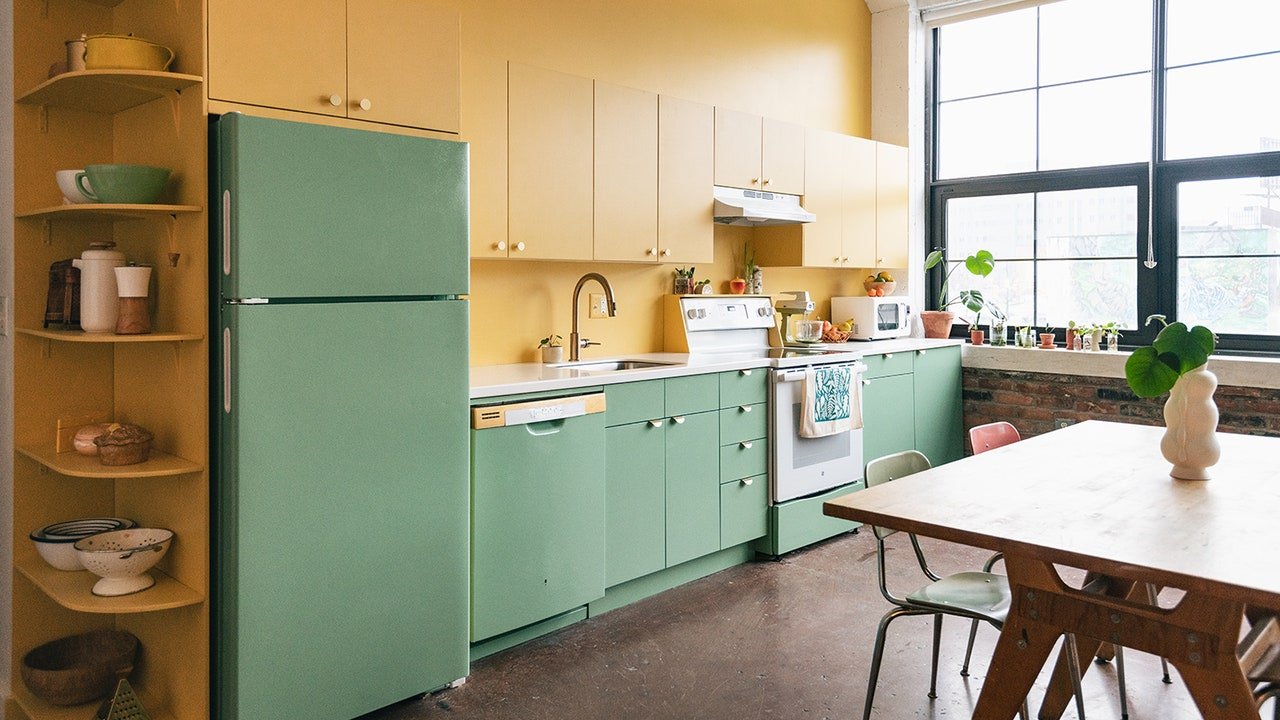Sure, You Can Paint Your Fridge
Prep the surface
Before you start, remove the brand logo. Hom says that these badges typically come off by wedging a putty knife under the emblem. For a stubborn adhesive, try this trick: With a hairdryer, warm up and soften the adhesive, then use dental floss to slice through and separate. Now, it’s time to remove door handles—these typically unscrew easily. If you choose to keep them on, but paint in a different color than the body of the fridge, use painter’s tape to maintain crisp lines. Tape is also helpful in working around the ice maker and the rubber seal on fridge doors.
Next, clean the surface. Dip a microfiber cloth in hot water to remove the first layer of grime. Apply a thin paste of baking soda and Dr. Bronner’s Sal Suds Biodegradable Cleaner on stubborn spots. Wipe down. Scruff-sand the corners and edges with 120 grit sandpaper to help with primer adhesion. “Most smooth surfaces will take paint if you rough it up first,” Hom says. She recommends wearing a mask to avoid inhaling dust. Wipe away any debris and remaining cleaning solution with water, then polish the fridge with a clean, dry microfiber cloth.
To prime or not to prime?
Depending on your paint choice, you may not need to prime. Wlasichuk opts for Annie Sloan Chalk Paint as it requires minimal prep (no primer), works equally well on different surfaces like plastics and metal, and dries quickly. For her vinyl, veiny-textured white fridge, Hom used Zinsser Ultimate Stain Blocker primer. A stainless-steel fridge will benefit from a coat of Farrow & Ball Metal Primer & Undercoat. Apply two coats with a four-inch foam roller and one-inch angle brush (in tight spaces).
Paint patiently
Given that a fridge is shaped like a box, actual paint application is fairly smooth. For a fridge exterior with a veiny surface, apply two coats with a foam roller, touching up with the angle brush, to make the texture less pronounced. “Don’t glob on too much, or it might look too chunky,” Hom warns. If your fridge is dinged up a bit, an eyeshadow brush helps get in the little nicks, Yates suggests. When painting the inside panels of the doors, keep it open, avoiding the sealers. A hairdryer can speed up the process.
If, like Wlasichuk, you’re using chalk paint, embrace the imperfections. “Chalk paint is not self-leveling,” she says. “You can build up texture or, if you’re after a smooth, modern finish, you can water it down slightly before painting or sand out any brush marks with a very fine grade sandpaper between coats.”
Don’t forget the details
Your ice box doesn’t have to look like a boring box. To echo the brass handles that glam up the lilac fridge, as well as the leopard upholstery on the kitchen chairs, Yates added her signature wildcat print to the ice dispenser, lining it with contact paper. Wlasichuk added character to her fridge with a fish motif lino print in white-and-black on the side of the fridge. After designating the relief spot with painters tape, she applied two coats of white, then stenciled on the relief in black. She removed the tape while the black paint was still damp to avoid cracking.


